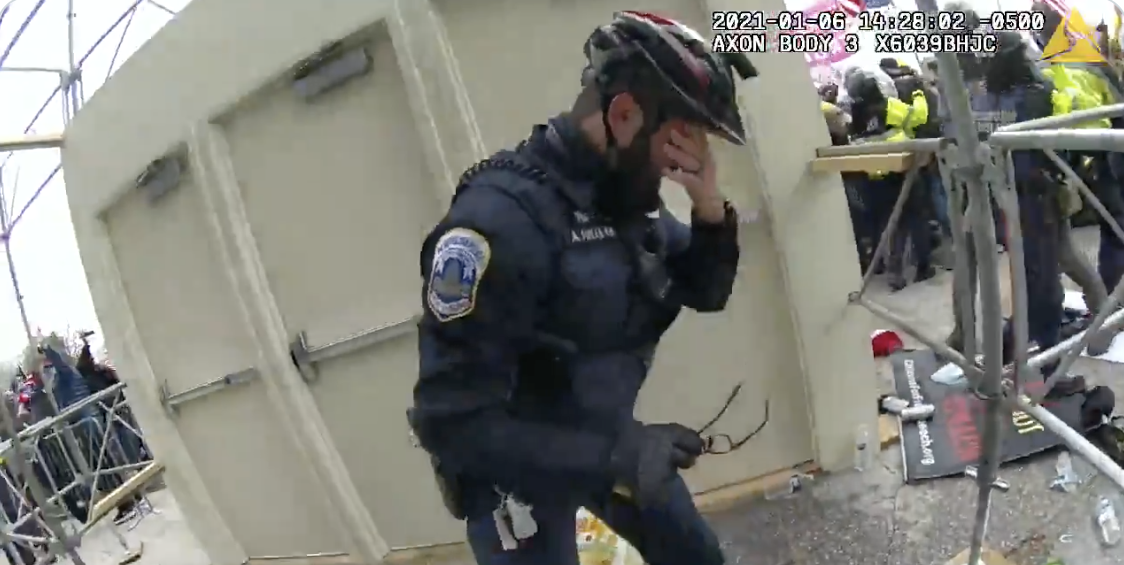Listen to the Crowd in This Clip From January 6

- Oops!Something went wrong.Please try again later.
There's some controversy at the moment over the fact that in trial proceedings for those accused of crimes relating to the events of January 6, federal prosecutors have exercised a virtual monopoly on releasing video of the events. The government's grounds for restricting defendants from getting video released that they claim will exonerate them seem spurious—they've typically cited Security reasons, labeling bits of footage "Highly Sensitive"—and as much video as possible should be released in the interests of transparency and the public's fuller understanding of the assault on the Capitol. (That's not to mention the prospect that video could actually be exonerating in some individual cases.) But what has been released—again, mostly at the direction of the Department of Justice—has left little doubt as to the wide sweep of events that day.
To wit, some significant section of the crowd clearly went to the Capitol with the intent to gain entry and disrupt the election certification proceedings. And it is clear that, in turn, some section of that group was prepared to turn to violence in order to gain entrance. There are many ways to discern this, not least the extensive video footage—much of it posted on social media by the assailants themselves—of people in Trump gear, sometimes carrying Trump or American flags, attacking police and breaking down doors and shattering windows. Some of that is evident in a Capitol Police officer's body cam footage, released Wednesday by the Department of Justice and picked up by NBC4 Washington Investigative Reporter Scott MacFarlane. But be sure to listen while you watch. Turn the volume up.
Every video released by the US Justice Dept has a story from the Insurrection
This new footage shows the danger lurking around seemingly every corner for police pic.twitter.com/LvdsPcMLbE— Scott MacFarlane (@MacFarlaneNews) July 21, 2021
The footage here gets at the absolute chaos on the ground that day, and the feeling of siege that the thin brigade of Capitol Police must have felt they were under for hours as backup was slow to materialize.
It's worth really listening to the crowd. Many of its members are engaged in a near-constant battle cry, some Viking shit. The kind of sounds people make when psyching themselves up for hand-to-hand combat. It is the roar of a group of individuals attempting to bind themselves together for a common mission, one that escalated to violent force. It gets the adrenaline going for each one individually, but the collectivism also brings reinforcement. You're not alone. We're all in this. It's not a cacophony, it's a kind of chant. We've seen this kind of thing in other footage, like the horrifying clip where a policeman is crushed against a door that a portion of the mob is trying to breach by pushing as one, yelling, "Heave! Ho!" That, too, brought to mind a medieval siege and a battering ram. But this clip points to the mentality in the larger crowd.
For unlimited access to Esquire's political coverage, including an exclusive weekly newsletter from Charles P. Pierce, you can join Esquire Select here.
It all evokes the visceral descriptions of how membership in the mob overcomes the individual human mind in Bill Buford's Among the Thugs, a chronicle of his time with English soccer fans involved in spasms of horrific street violence during the heyday of European hooliganism.
He is merely the first to cross an important boundary of behavior, a tactic boundary that, recognized by everyone there, separates one kind of conduct from another. He is prepared to commit this "threshold" act—an act which, created by the crowd, would have been impossible without the crowd, even though the crowd itself is not prepared to follow: yet.
The crowds in Buford's book engage in violence for its own sake, for the thrill that Buford himself admits takes on an almost seductive appeal. It's a primal experience, an appeal to base instincts we've all papered over with layer upon layer of polite civilization, one which the hooligans may have sought out in the belief civil society had failed them or left them behind. Or maybe, in some cases, they were just truly antisocial personalities. Buford spends some time exploring what drives people to seek membership in the mob, but more than anything, he describes the kind of psychological dynamics that drive a group of people to become a unified agent of violent destruction—clear of purpose, even if it's never stated explicitly.
There is little doubt that, for some section of the crowd that arrived at the Capitol on January 6, that is what the event became. This is not what tourists sound like, and we're not just talking about the people calling for the Vice President of the United States to be lynched. There were no hugs and kisses here, not among those who crashed into those tasked with keeping order while members of the Legislative Branch, a group of freely elected officials imbued with legitimate power through the expressed will of the governed, conducted their basic constitutional duties. It was an assault on the democratic order, an attempt to use force to claim power.
You Might Also Like

